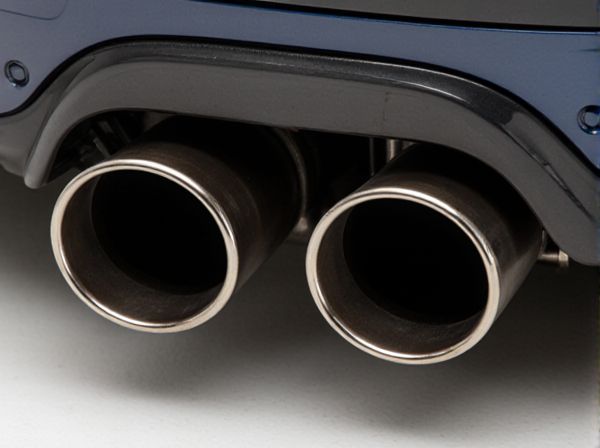
Photo illustration: Exhaust Pulse Tuning vs Backpressure Tuning
Exhaust pulse tuning enhances engine performance by optimizing the timing and intensity of exhaust gas pulses to improve scavenging and increase power output. Backpressure tuning focuses on managing exhaust resistance to ensure proper exhaust flow without causing excessive engine load or heat buildup. Your choice between these methods depends on the desired balance between power, efficiency, and engine longevity.
Table of Comparison
| Feature | Exhaust Pulse Tuning | Backpressure Tuning |
|---|---|---|
| Definition | Optimizes exhaust pulses to improve scavenging and power. | Adjusts exhaust backpressure to influence engine performance. |
| Performance Impact | Enhances horsepower and torque by improving gas flow. | Can increase low-end torque but may reduce peak power. |
| Efficiency | Improves fuel efficiency through better exhaust flow. | May cause fuel efficiency loss due to restricted flow. |
| Sound Characteristics | Produces sharper, more aggressive exhaust notes. | Results in deeper, muffled sound due to restriction. |
| Best Use Case | Performance tuning for high-revving engines. | Suitable for improving low-end torque in daily drivers. |
Introduction to Exhaust Pulse Tuning vs Backpressure Tuning
Exhaust pulse tuning focuses on optimizing the timing and scavenging effects of exhaust gas pulses to improve engine performance and efficiency by enhancing cylinder evacuation. Backpressure tuning involves manipulating the exhaust system's resistance to control exhaust flow characteristics, influencing torque and power delivery across different RPM ranges. Understanding the differences between these techniques is essential for tailoring exhaust design to specific engine goals and performance outcomes.
Understanding Exhaust Flow Dynamics
Exhaust pulse tuning optimizes the timing and interaction of pressure waves within the exhaust system to enhance scavenging and improve engine performance by efficiently clearing exhaust gases from the combustion chamber. Backpressure tuning focuses on controlling the resistance the exhaust gases face while exiting the system, influencing torque and power delivery by adjusting the exhaust restriction levels. Understanding exhaust flow dynamics involves analyzing how pressure waves and backpressure interact to balance scavenging efficiency and engine power output.
Principles of Exhaust Pulse Tuning
Exhaust pulse tuning optimizes engine performance by precisely timing pressure waves generated by exhaust valves to improve scavenging and volumetric efficiency. These pressure pulses create negative pressure waves that evacuate exhaust gases and promote fresh air intake, enhancing combustion and power output. In contrast to backpressure tuning, which relies on increased exhaust resistance, exhaust pulse tuning leverages wave dynamics for superior engine breathing without sacrificing flow.
Fundamentals of Backpressure Tuning
Backpressure tuning focuses on managing the pressure within the exhaust system to optimize engine performance and efficiency by controlling exhaust gas flow resistance. This method adjusts exhaust components such as mufflers and catalytic converters to create enough backpressure to enhance torque and reduce emissions without excessively restricting the engine's power output. Understanding the relationship between backpressure and engine scavenging efficiency is critical for maximizing the benefits of backpressure tuning in various engine configurations.
Performance Impact: Pulse Tuning vs Backpressure
Exhaust pulse tuning enhances engine performance by optimizing the timing and intensity of pressure waves to improve scavenging and volumetric efficiency, leading to increased horsepower and torque. Backpressure tuning, while useful for controlling emissions and noise, can restrict exhaust flow and reduce engine efficiency, often resulting in lower performance gains. Studies show that pulse tuning delivers superior throttle response and power output by utilizing exhaust wave dynamics rather than relying on elevated backpressure.
Effects on Engine Efficiency and Power
Exhaust pulse tuning improves engine efficiency by optimizing the timing of exhaust gas waves, which enhances scavenging and increases volumetric efficiency, resulting in higher power output. Backpressure tuning, on the other hand, typically restricts exhaust flow, which can reduce engine performance and cause power losses by increasing pumping losses. Engine power is maximized when exhaust pulse tuning balances pressure waves to promote efficient gas evacuation without excessive backpressure that hinders exhaust evacuation.
Applications in Different Engine Types
Exhaust pulse tuning enhances engine performance by optimizing the timing of pressure waves in the exhaust system, which is particularly effective in naturally aspirated engines and high-revving sportbikes. Backpressure tuning maintains a certain level of exhaust restriction to improve low-end torque and drivability, making it suitable for turbocharged engines and heavy-duty diesel trucks. Each method targets specific engine characteristics: pulse tuning improves scavenging and volumetric efficiency, while backpressure tuning supports boost response and exhaust gas recirculation.
Pros and Cons of Each Tuning Method
Exhaust pulse tuning optimizes engine performance by precisely timing the scavenging effect of exhaust gas pulses, improving horsepower and throttle response but requiring complex design and higher manufacturing costs. Backpressure tuning enhances low-end torque and reduces emissions by increasing exhaust resistance, though it can restrict airflow and reduce peak engine output. Choosing between these methods depends on the desired balance of power, efficiency, and engine characteristics.
Common Misconceptions and Mistakes
Exhaust pulse tuning and backpressure tuning are often confused despite their distinct functions in engine performance optimization. A common misconception is that increasing backpressure always improves torque, whereas excessive backpressure can actually reduce engine efficiency and power output. Many enthusiasts mistakenly apply backpressure tuning methods to exhaust pulse systems, overlooking that pulse tuning relies on precise timing of pressure waves to enhance scavenging and should be optimized through pipe length and diameter rather than restricting flow.
Choosing the Right Exhaust Tuning for Your Engine
Exhaust pulse tuning improves engine efficiency by optimizing the timing of exhaust gas pulses, enhancing scavenging and increasing horsepower at specific RPM ranges. Backpressure tuning controls the overall exhaust gas flow resistance to maintain sufficient pressure for low-end torque and throttle response. Selecting the right exhaust tuning balances performance goals and engine characteristics, with pulse tuning ideal for high-revving applications and backpressure tuning suited for engines requiring strong low-end torque.
 caratoz.com
caratoz.com